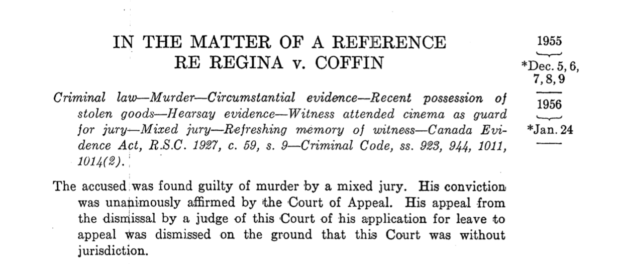1956: The Coffin Affair & Other Quebec Curios
Part of “Shadows and Revolution”, 1900-1960
Wilbert Coffin was firstly a Gaspésien. A prospector by trade, his chance run in with three men and six hundred dollars led to one of the most hotly-debated cases in Canadian legal history.
Three Pennsylvanian tourists—Eugene Hunter Lindsay, his son Richard Lindsay, and his son’s friend Frederick Claar, were eager to hunt in Québec, and had obtained hunting permits to do so in early June. Travelling up north to the Gaspé region, Eugene Lindsay with about six hundred dollars in his pocket, they did some groceries before starting on their hunting trip, except one thing hindered them: their car broke down. It was at that moment that the three Americans met Wilbert Coffin, who offered to give them a lift. They were never seen alive again. Pressure mounted on the Québec government to find the men, and they did: three weeks after they went missing, their remains were found, ravaged by the very bears that they had went out to kill. However, who killed the three men?
Coffin’s guilt was based mostly on circumstantial evidence: since nobody saw Coffin kill the three men directly, the Crown prosecutor relied on testimony from witnesses that saw Coffin with the three tourists—a man at the garage, for instance—or who had interacted with Coffin after the fact. Coffin was indeed found to have American money on him, whereas the wallet found on the body of Eugene Lindsay had been completely emptied. However, was this enough to conclude he was guilty?
The 1954 trial was conducted in English only, though the jury was composed of both French and English jurors, six out of which were unilingual francophones. The jury deliberated for only thirty minutes before they decided that the circumstantial evidence was enough to conclude that Coffin killed one of the three men—that is, the son, Richard Lindsay, who was seen alone with Coffin by one of the witnesses.
Coffin appealed his case to the Court of Appeal, where his pleas for a new trial were once again quashed. The case’s notoriety grew, and it was in part due to the sensational nature of the trial that the federal government itself appealed to the ultimate law of the land — the Supreme Court of Canada.
Seven judges were present to hear Re: R. v. Coffin, and a majority of five upheld the lower courts’ rulings. In a jurisprudence still taught today, the judges concluded that showing a witness information that they had sworn under oath to have been the truth about the events was not contrary to the pursuit of justice. This idea, known unofficially for years as a Coffin Application, permitted lawyers to show witnesses items such as previously written statements that had been written under oath in order to refresh their memory (rather than to discredit them). Though this piece of jurisprudence settled a theoretical question, its consequences were clear: Coffin was to be executed.
In an unusual turn of events, Coffin’s common-law wife had wished to marry her partner before he was to be hanged, but Maurice Duplessis himself intervened and forbid their union. Until the very end, Coffin denied that he had murdered the men. He was hanged over the night of February 9, 1956. In accordance with the Bordeaux prison’s traditions, seven chimes tolled out to signal the execution. Since Coffin’s execution, his guilt has been repeatedly been called into question, most notably by people such as Jacques Hébert and Clément Fortin.
The death penalty was abolished in Canada in 1976, twenty years after Wilbert Coffin was hanged.
Read the Supreme Court decision here.





